- Home
- S. E. Hinton
Some of Tim's Stories Page 10
Some of Tim's Stories Read online
Page 10
What are some of your all-time favorite animal books besides Old Yeller?
When I was in grade school, I absolutely loved Duff, the Story of a Bear. I read that book over and over and over. And Marguerite Henry’s horse books with those fabulous paintings. King of the Wind was one of my favorite books for many years. Then Ernest Thompson Seton’s Wild Animals I Have Known. He made the point that no animal in the wild dies of old age, so naturally all of his short stories had tragic endings, and the animals were written about just as if they were people. I remember the story about the fox who could raid the hen house until the farmer figured him out. As a younger kid, I loved being outdoors, taking walks through the woods, so wild-animal stories are especially fascinating to me.
In your picture book and your chapter book, you get to display your sense of humor. Was that liberating for you? Your earlier work had some pretty serious overtones.
My sense of humor is one of my strongest personality traits, but—I don’t know why—these are the first books where it’s really come through. Tex was inclined toward pranks, which I’m not, so even though he had a sense of humor, it was quite different from mine. So it was liberating to get to express that part of myself.
You’ve already established that Big David, Little David and The Puppy Sister are decidedly autobiographical. At what point does fact become fiction?
Well, Aleasha didn’t turn herself into a real human, but she did turn herself into a member of the family.
Would you agree with Grace Paley that any story told twice is fiction?
That’s a good one. Yes, and better for it.
In 2004 you wrote Hawkes Harbor. Why did you decide to write a book about a vampire?
I don’t really believe in vampires. The vampire actually was more of a character definition. My books show character growth. Jamie Sommers was fearless, but he’s in a mental hospital, and one of the first things he tells his doctor is about the time he was smuggling jewels out of Burma, got captured by pirates, jumped into the ocean to save a ruby, and got attacked by a shark. The doctor thinks he’s a nut case with an imagination, but his story turns out to be true. Something has happened to break him.
And as if that weren’t enough, he meets a vampire.
The vampire, Grenville, was interesting, because I portrayed him as a man who really valued his self-control. For him, being a vampire was like being a drug addict. He couldn’t break himself; he wasn’t proud of it. But he relished the power that being a vampire gave him.
Did you have any other vampire characters in mind as you wrote the book?
When Grenville and Jamie got together, I was also thinking about the original Dracula and Renfield, the cowering little servant. That whole relationship fascinated me.
Publishers Weekly described the book as “swashbuckling,” not exactly what you’d expect for a horror novel.
I felt trapped writing teenage books with drama and meaning—or no meaning—and I wanted to go back to when writing was really fun. I’d just re-read Treasure Island, and I had a great time making up Jamie’s adventures. After Jamie told his psychiatrist about being in Burma, I went to the globe and saw the Andaman Islands. I looked them up in the dictionary and found out they are beautiful, pristine, but also hangouts for really bad people, so I had Jamie’s boat break down near the islands. Then the next issue of National Geographic had an article on Burma in the 1960s. The socialist government was collapsing, and two-thirds of the net national income was from smuggling. So many synchronicities kept happening to me while I was writing the book.
Kellen Quinn, Jamie’s best friend, is a great character, an Irish con man.
I loved writing his dialogue with Jamie. He had quite a vocabulary, and Jamie was not particularly verbal, but he liked to listen to Kell’s stories.
As you just mentioned, much of the book takes place in the 1960s, specifically 1967, the same year The Outsiders was published. Is that just a coincidence, or was your subconscious at work again?
My subconscious was at work again, because I realized after I’d written the book that I was using the vampire as a metaphor for the Vietnam draft. People forget how it was. The draft could yank you out of your life, subject you to horrors, then send you back to a country that despised you. Jamie is ripped out of his life by the vampire, subjected to horrors, and driven crazy. The vampire holds him in contempt, but at the end, he and Jamie have gradually learned to respect each other. I actually even mention the Vietnam situation. When Jamie’s first sent to the state mental hospital, a lot of Vietnam vets are patients.
The book operates in several different time frames. We’ve talked about the ’60s, but there’s an opening prologue dated 1950. Why did you choose the nonlinear structure?
Jamie was a tactile learner. He wasn’t a reader, but he liked to work jigsaw puzzles. I realized after I did the book that I was working a jigsaw puzzle. Something will be mentioned in one chapter that will only make sense several chapters later. I think that gives the reader a feeling at the end of having lived a lifetime with somebody.
You’ve used the name Jamie before with your female character in Tex. Is there any connection?
No. I tried to come up with a lot of different names for the character. Jamie just seemed to be the one that suited him.
Horror guru R. L. Stine wrote that he wanted to echo Jamie’s plea, “Don’t let it be dark.” How did that plea originate within you?
I’m not sure. I’m not scared of the dark. I like swimming out in the pool at night by myself. On the surface, Jamie connects the dark with the time the vampire first gets him and torments him. But also Jamie, who was pretty fearless, was in the dark about life. Like when he was running guns with Kell. He was doing a job, getting paid well. It was a little dangerous, but he was totally in the dark about the principle until he realized these guns were going to be used to murder men, women, and children. He’s enlightened by the end of the book.
Like Taming the Star Runner, Hawkes Harbor is written in third person. Was that a calculated decision on your part, or was that just how the story came to you?
It was calculated. I wanted the freedom in Hawkes Harbor to be all over the map, and not just geographically. I was in Burma, I was in Bangkok, I was in the Riviera. Some paragraphs come from the mind of Kell. A few paragraphs come from the mind of the vampire, and from some other characters, too.
You mentioned that this book takes place all over the world, not in Oklahoma like your other books. Why did you decide to shift locales?
Well, I’ve done Oklahoma to death. I realized later that Jamie and Kell met in Hawaii and kept going farther and farther west. Their first stop was in the Philippines, and then they were in Burma, the French Riviera, Liverpool. It’s hot in Burma, but by the end of the book, in Washington, D. C., it’s snowing. It’s gotten colder and colder and colder. That was an interesting motif.
In Hawkes Harbor you were writing to an adult audience for the first time in your career. How did that feel?
I’ve always wanted to know if I could do sex scenes, and so there are about three in the book. They’re not gratuitous; they’re illustrating Jamie’s sex education. Kell gets mad at Jamie for buying hookers, because he doesn’t need to—he’s young; he’s good-looking. When he does finally fall in love with a girl, he realizes affection might be the next step.
Many of your fans loved Hawkes Harbor, but some were uncomfortable with the book. Did that surprise you at all?
I knew a lot of people would think it was strange. It’s funny to me because a lot of people were shocked that there was a vampire in it. I gave plenty of clues, so I didn’t think it was going to be any huge surprise when it turned out Mr. Hawkes was not exactly what people thought he was. People seem to have so many ideas about what I’m supposed to be writing, but I’ve never let anybody dictate what I write. On the other hand, I do get
fan mail from people who just loved Hawkes Harbor. One woman wrote and said she was in love with Jamie after the first chapter. That was nice. And I think the characters are some of the best I’ve ever done.
Do you plan on more horror novels, or was Hawkes Harbor a literary diversion?
The book I’m working on now is a paranormal suspense comedy—set in Oklahoma.
Do all of your books, as diverse as they are, relate to extended family?
Absolutely. Like the puppy becoming a member of the family, even though she and Nick actually didn’t have a whole lot in common. In The Outsiders, Ponyboy did not like Dallas in the beginning, but he did admire him by the end of the book. And Grenville and Jamie end up being family members. Jamie had been searching for a father figure all his life, and he went through several of them—the priest, Kell, Grenville. All my books are about relationships.
Tim
Look at this gorgeous superstar—and Matt’s not bad either.—S.E.H.
JULY 26, 2006—TULSA, OKLAHOMA
The dishwasher is humming in the kitchen as Susie and I admire the framed photo of Matt Dillon riding her horse Toyota. The picture, she tells me, was taken during the filming of Tex, and she’s left it on the den coffee table so we can consider it for the book. Matt and Toyota leave little to the imagination. They’re not posing. They’re naturally young and bold, reined in by the camera, but ready to bolt to a different realm. Susie’s also preoccupied with two black-and-white illustrations for Tim’s stories, one a work in progress. “This needs to be a little rougher,” she says, calling my attention to the image of a worn chair, draped with a banner that reads, “Welcome Home Terry.” She goes on to explain that she means rougher like Tim himself, though he’s not depicted in the drawings or the stories. The other sketch, featuring a smoldering cigarette, suggests that Tim has just stepped away from the scene for a minute, but, like us, can still hear the dishwasher and see Matt in the distance.
The stories in your collection, Some of Tim’s Stories, focus on Mike and Terry. Who exactly is Tim?
Tim is the author of the stories. I took a roundabout way of writing in first person, using a narrator who writes his stories in third person. That sounds confusing, but I pictured Tim as a bartender in his late twenties, working in some small northern Oklahoma town. He went to a community college to take computer courses for his job, enrolled in some other courses, got interested in short stories, and decided to write about his life. But he disguised the stories.
How did you get to know him well enough to make him a tangible presence?
I had to establish a strong back story for Tim. The stories are short, so I needed to know every detail of his life. I had to be Tim when I was writing them, and his ideas were totally different from mine. He was not for gun control. He was very, very antiabortion. I’d never felt so masculine in all my life, even though I’ve always used male narrators and male characters. I even began thinking like a bartender and bouncer. Friday nights are tougher than Saturday nights from the bouncer’s point of view because on Fridays people think they deserve their fun—their hard week is over. By Saturday, they’re more relaxed. I don’t know how I understood that, but I did.
Did you do any research?
I read Bartending for Dummies and visited a few bartending sites on the Internet.
How significant is it that Tim’s a bouncer as well as a bartender?
The fact that Tim’s a bouncer factored into the story because he’s not a violent person. Even though he has that potential, he would rather prevent a fight than stop one after it’s started.
Did Tim become a presence in your life as well as the stories?
One time when my husband, David, got home, I was telling him what was going on in the bar that night, and he said, “You’re starting to sound like him.” Tim had a heavy voice, and his words carried weight.
How did you see him physically?
Very strong. He was 6’2”. He weighed 185 to 190 pounds. He was big-boned but not heavy. His nose had been broken twice, but because he was heavy-boned, it looked okay. He had a lot of presence to him, even though he was quiet. He always wore a baseball cap, and his customers would bring him caps from the different places they’d been. He had quite a collection. The customers had grown to like him because he was a good listener. He also wore Wranglers—or whatever blue jeans were on sale at Kmart—and Timberland lace-up boots. The boots originally started out mustard-colored, but he had spilled so many things on them they’d turned tan.
Tim never makes even a cameo appearance in the stories. Do you think readers can really get to know him through what he’s written?
Definitely. Even though he called his character Mike, he mentions his aunt and his mother and the step-father he refers to as “the step-bastard.” Tim had lost his father when he was ten. His father had played a huge role in Tim’s life, and I think you can pick that up in the stories, too.
Why was it important for you to filter these stories through Tim?
It was a different narration process, and I enjoy being different sometimes. Because these stories are very short, they are an arc of life, and they mention things repeatedly. Mike—or Tim—carries guilt for not being in prison with his cousin, when he is just as guilty. That guilt shows up even when it doesn’t have anything to do with what’s happening in a particular story. To me the stories are a novel in a very condensed form.
How is Tim’s writing style different from yours?
When I first started writing from Tim’s point of view, I was amazed I couldn’t do dialogue, because dialogue is my strong point. But dialogue was the hardest part of fiction writing for Tim. In the earlier stories there’s not much. But as he got more relaxed with his writing, he got more comfortable using dialogue, too.
Did you ever find yourself slipping out of character and writing as S. E. Hinton?
Not with Tim’s stories. I was so involved being that narrator that I found myself being Tim when I should have been S. E. Hinton.
Ever get any Wranglers at Kmart?
Wranglers, no. And I didn’t feel any desire to be addicted to Jack Daniel’s, which Tim was, or to smoke, or to wear Timberland boots.
How fully did you come to trust Tim as the storyteller?
I trusted him absolutely, because he wasn’t writing for publication. He was in love with his creative writing teacher at Tulsa Community College, and that was why he started writing. With her encouragement he got bolder and more fixed in his ideas of what made a story. He wasn’t interested in description at all, not as a reader, not as a writer, and yet the stories themselves are very descriptive. He’s not saying, “The beautiful green trees by a wonderful blue lake,” but he still gives a strong visual for each story.
What are some of his storytelling eccentricities?
He could never hit the apostrophe button, because his big-boned finger always hit the semicolon instead. This doesn’t show now because he always went back to polish. When he wrote through the stories the first time, there was no capitalization or punctuation because he just wanted to get them down, and he wasn’t fast. A lot of times he wrote stories out in longhand at first because he didn’t have a computer at home; he had to wait and use the one at the bar. Also he always used the word “yes,” except once or twice he’d say “yep” when he was in conversation, but not “yeah.” And there was a finality about the way he would say “yes.” I think he got that from his father, who always had that way of saying “yes.”
So you knew the whole family, so to speak?
Yes. Tim’s mother wasn’t a strong woman. When her husband died in a car wreck, she was floundering, married a man she thought would take care of her, and then wasn’t strong enough to prevent his abuse of Tim, who left home at seventeen. By the way, Tim finished high school just because the step-bastard said he couldn’t.
Of all your firs
t-person narrators, which one is the most like Tim?
None of them even come close.
What about technically speaking? Did you have some of the same challenges writing as Tim that you had writing as Rusty-James in Rumble Fish? Neither is the gifted observer that Ponyboy is.
Tim was so much smarter than Rusty-James. He could learn from his mistakes and profit from them—or at least know he’d made them, whether he could control making them again or not. Rusty-James was so oblivious.
But he still isn’t a sophisticated storyteller. What is his strength as a writer?
I think the emotional intensity that he brings to his stories. His stories had to start with an emotion.
How did you come up with the premise for the stories, each limited to about a thousand words?
For the heck of it. It’s like taking dressage, horseback riding: it’s a strong discipline, and it’s wearing, but it’s an accomplishment when you feel you finally got it right. There are some Zen-like moments. When I first started, I’d think there is no way I’m going to be able to cut a story down to a thousand words, but I’d go back, trim it, then trim it again. In my later stories, I would know I had 995 words without ever looking at my word count.
In our very first interview you said that you’d revised The Outsiders by adding detail and scenes. How did you pare these stories down to fit the prescribed word length? What sorts of things did you find yourself cutting out?
You’d be surprised at how much you don’t need in a story. I found out you could do without a lot of adjectives. And without a lot of explanation. In “Different Shorelines,” the story takes place on a lakeshore at different times of the year and in different years, beginning, I think, in 1987. It’s spring, and then you go into summer one year later. But you’re always at the same lakeshore, and you don’t have to describe it. The conversations explain what’s going on.
Do you think that—ironically—in some ways you were able to say more with fewer words?

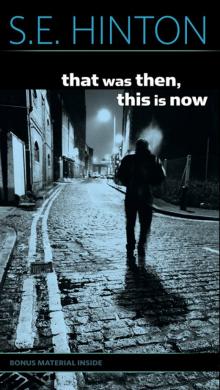 That Was Then, This Is Now
That Was Then, This Is Now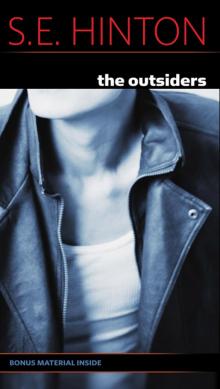 The Outsiders
The Outsiders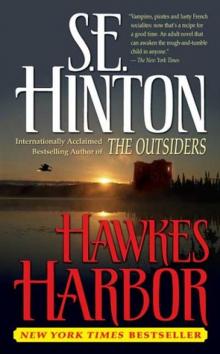 Hawkes Harbor
Hawkes Harbor Taming the Star Runner
Taming the Star Runner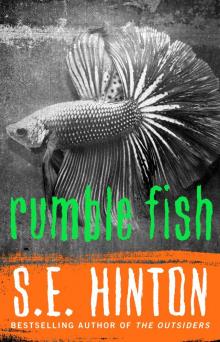 Rumble Fish
Rumble Fish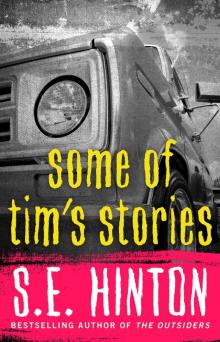 Some of Tim's Stories
Some of Tim's Stories